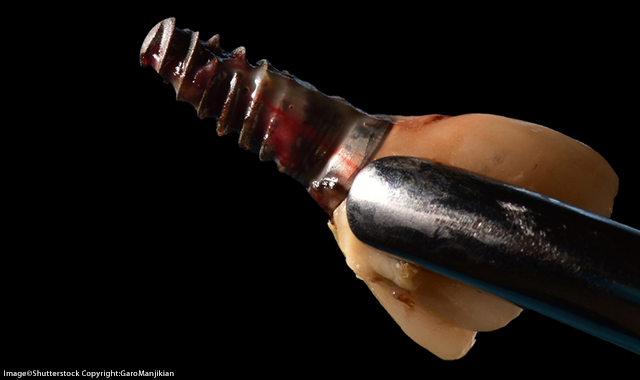How to solve the peri-implantitis problem
Why one dentist believes the status quo isn’t good enough, and why OraCare is a better way forward.

Earlier this summer, researchers at the University of the Basque Country published a study that concluded that the use of chlorhexidine, a chemical widely used to combat bacteria in tooth extractions and implant placements, has a limited effect.
While chlorhexidine only prevented bacteremia in 12 percent of cases, the researchers still recommended using chlorhexidine because the positive (but minimal) effects outweighed the risks.
I recently spoke to a dentist who begs to disagree. Dr. Robert Martino is part of a team of oral health professionals who have identified a use in dentistry for a technology that is frequently used elsewhere (such as in water treatment). They believe this technology is a much more effective alternative to chlorhexidine, and I wanted to find out why.
Trending article: What you need to know about oral rinses
Why do dentists need this technology?
Studies show that as many as 47 percent of all dental implants have peri-implantitis, and more than 10 percent of all dental implants fail with that as the major cause. Many of these implants can become unstable or at least cause gingival shrinkage, which can cause a poor cosmetic outcome. OraCare’s Implant Post Op Care System was designed specifically to fight and prevent peri-implantitis.
Check out this video to learn more about OraCare.
How are dentists protecting their implants now?
I think there are two options right now: either they put the implant in and just hope and pray that everything is going to go well and that the patient’s going to keep their mouth clean, or they’ll use something like chlorhexidine, which, in my opinion, is contraindicated for implants because of all the side effects.
Chlorhexidine was designed to treat gingivitis, not heal the gums after an implant. One of the keys for preventing peri-implantitis is prevention of plaque and calculus buildup. One of the major challenges of chlorhexidine is that it causes staining and calculus buildup and does nothing to neutralize volatile sulfur compounds or break up biofilm (dental plaque). More serious side effects include inhibiting fibroblasts, which we need for tissue repair. It can also only be used for two weeks, but it takes at least 30 to 34 days for the gingiva to heal. Although chlorhexidine does a good job of killing bacteria, we’re worried that it does more harm than good.
How do you get the dental team excited about this product?
Implants are such an investment for the patient and the doctor. If you haven’t had an implant fail, you probably haven’t done enough of them. Failure can mean that the implant becomes unstable and needs to be removed. You can also have a cosmetic failure, where the gingiva around the implant shrinks because of an infection. What’s exciting is that we now have a system to help prevent failure.
Tell me about the technology behind OraCare
We use activated chlorine dioxide, an ingredient that has been used for over 200 years to sterilize instruments, remove odors, fumigate infected buildings and purify water. By incorporating activated chlorine dioxide into a mouthwash and gel, we can kill bacteria, viruses and fungi, break up biofilm and eliminate volatile sulfur compounds, which bacteria excrete after they die. OraCare doesn’t cause staining or calculus buildup and can be used long term. It also has a pleasant taste, resulting in high patient compliance.
Trending article: Is professional subgingival oral irrigation necessary?
Where did you get the idea to use activated chlorine dioxide in a rinse?
One of our founders, Dr. Rick Downs, had been trying to find something that would replace chlorhexidine without the staining. It also needed to have high patient compliance and be safe for indefinite use to kill all of the factors that cause periodontal disease. Killing bacteria isn’t the only concern when dealing with gum disease or peri-implantitis, because other factors like volatile sulfur compounds, viruses and fungi all play a role.
Gum disease, whether it’s around a natural tooth or an implant, doesn’t just happen once. It’s a never-ending battle. We don’t think the mechanical removal of plaque and bacteria by just brushing and flossing is enough, so that’s why we came up with OraCare.
Why offer OraCare in gel form too?
The gel, similar to the rinse, is made with two separate ingredients that, when combined, form a gas. The gel offers a slower release and is three times as strong as the rinse. So we’re really making an impact right after surgery to make sure everything is eliminated as soon as possible, then the patients go home and use the rinse for the next month at least.
Can OraCare be used for both prevention and rehabilitation of an implant that has peri-implantitis?
Yes. The sooner you can eliminate the pathogens, the healthier your tissue and bone will be. Once an implant has been compromised by peri-implantitis, the activated chlorine dioxide rinse and gel can also be used to help eliminate the infection and rehabilitate a healthy periodontium.
ACTIVA BioACTIVE Bulk Flow Marks Pulpdent’s First Major Product Release in 4 Years
December 12th 2024Next-generation bulk-fill dental restorative raises the standard of care for bulk-fill procedures by providing natural remineralization support, while also overcoming current bulk-fill limitations.